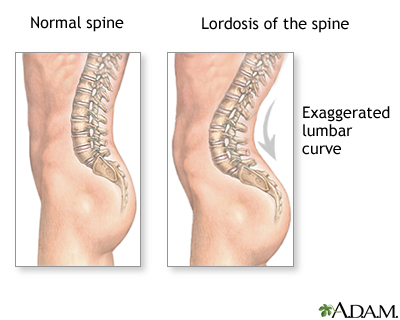Lordosis
From Wikipedia, the free encyclopedia
| Lordosis | |
| Classification and external resources | |
| ICD-10 | M40.3-M40.5 |
|---|---|
| ICD-9 | 737.2 |

Lordosis (commonly referred to as swayback, saddle back, or hyper-lordosis) is a medical term used to describe an inward curvature of a portion of the vertebral column.[1] Two segments of the vertebral column, namely cervical and lumbar, are normally lordotic, that is, they are set in a curve that has its convexity anteriorly (the front) and concavity posteriorly (behind), in the context of human anatomy. When referring to the anatomy of other mammals, the direction of the curve is termed ventral. Curvature in the opposite direction, that is, apex posteriorly (humans) or dorsally (mammals) is termed kyphosis. Some animals (notably horses) have naturally concave, lordotic backs.
Contents[hide] |
[edit] Cause
Lordotic curvatures of the vertebral column, also known as secondary curvatures are caused mainly because of the difference of thickness between the anterior and posterior part of the intervertebral disc. It can also worsen through puberty sometimes not becoming evident until the early or mid-20s. Imbalances in muscle strength and length are also a cause, such as weak hamstrings, or tight hip flexors.
Excessive lordotic curvature is also called hollow back, saddle back, and swayback. Common causes of excessive lordosis including tight low back muscles, excessive visceral fat, and pregnancy. Although lordosis gives an impression of a stronger back, ironically it can lead to moderate to severe lower back pain. Loss of lordosis is sometimes seen with painful spinal conditions. If rigid, usually after spinal fusion surgery, it is known as flat-back.
The familiar overly-concave shape of the horse's back is, by extension, described as lordotic (hence the nickname "saddle back").
[edit] Treatment
Lordosis of the lower back may be treated by strengthening the abdominal muscles and hamstrings. Back hyper-extensions on a Roman chair or inflatable ball will strengthen the back muscles. Anti-inflammatory pain relievers may be taken as directed for short-term relief. Physical therapy effectively treats 70% of back pain cases due to scoliosis, kyphosis, lordosis and bad posture.
[edit] Other
Lordosis behavior refers to the position that some mammalian females (including humans, cats, mice, and rats) display when they are ready to mate ("in heat").
[edit] Footnotes
[edit] References
- Gylys, Barbara A. and Mary Ellen Wedding (2005), Medical Terminology Systems, F.A. Davis Company
[edit] See also
[edit] External links
| |||||||||||||||||||
'건강하고 행복하게 > 建康 運動' 카테고리의 다른 글
| What are your core muscles? (0) | 2009.06.23 |
|---|---|
| Multifidus Muscle: (0) | 2009.06.23 |
| Stabilizer Muscles (0) | 2009.06.22 |
| Mobilizer(Mover), Stabilizer Muscle (0) | 2009.06.22 |
| Anatomy of the Shoulder (0) | 2009.06.20 |